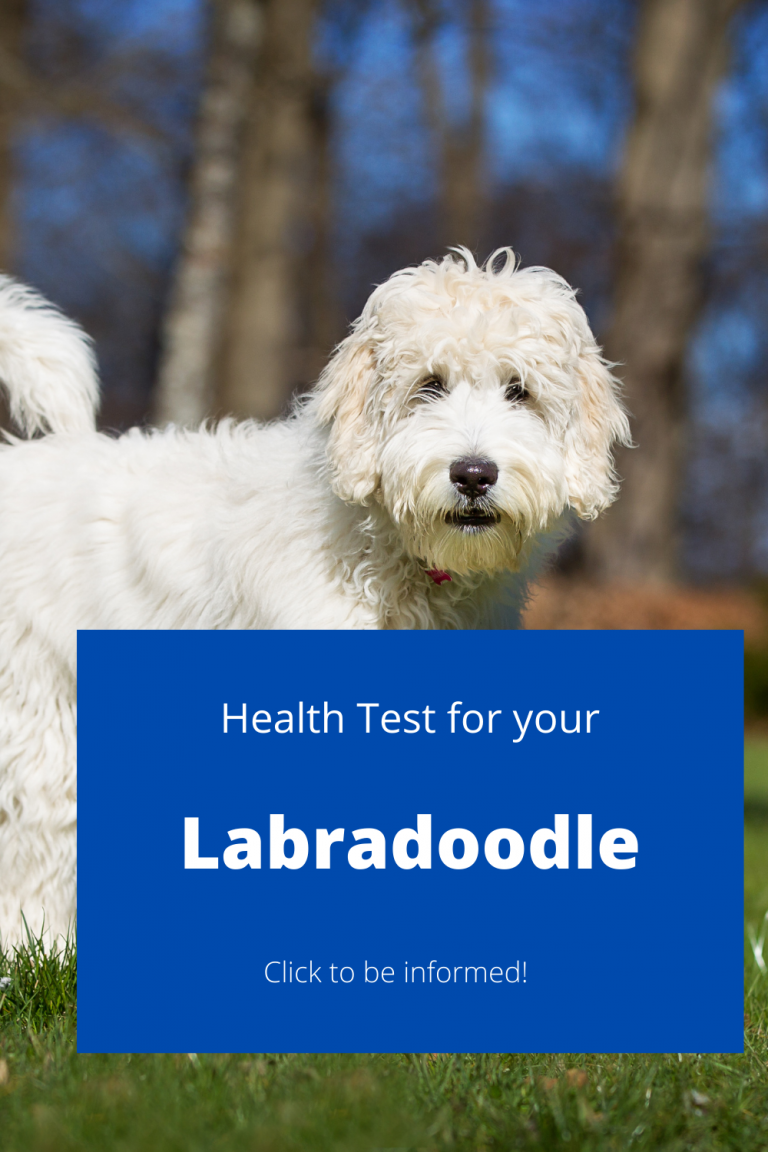
What Type of Health Tests does my Labradoodle need?
Labradoodles are cute, affectionate and super popular. There are certain health tests and screening recommended before adopting or buying your new loyal best friend to help keep your labradoodle as healthy and happy as possible.
The name ‘Labradoodle’ is given to a cross between a Poodle and Labrador. This is usually a Standard Poodle but smaller Poodles are sometimes used to breed a smaller dog. Generally Labradoodles are largish dogs. The offspring of such a mating is known as an F1 cross and may have the added benefit of heterosis or ‘hybrid vigor’. If two Labradoodles are mated together, this is known as F2. An F2 bred to an F2 will result in an F3, and so on. If an F1 is bred back to either parent breed it is an F1B.
The labradoodle’s personality will vary, if well socialised as puppies, the labradoodle will be a lively and good natured family pet. There is the potential for owners to be less allergic to labradoodles, but zero or low allergy is not guaranteed even within the same litter. It is claimed that labradoodles will not shed their coats but this is not guaranteed as labradoodle coat type is varied.
Ask the breeder about the medical history of the parents, grandparents and great grandparents. Consider carefully whether to purchase a puppy if diseases are in the family line.
Ask about the breeder’s policy in cases of serious genetic diseases occurring to your puppy in later life. Good breeders will request to be informed of such events in order to improve future breeding decisions.
Suggested Health Tests for labradoodles
OFA
This is a Hip and Elbow test used prior to breeding specifically to address: Carpal subluxation, Elbow dysplasia, Epiphyseal dysplasia, Fragmented coronoid process, Hip dysplasia, Hypertrophic osteodystrophy, Multiple epiphyseal dysplasia, Muscular dystrophy, Osteochondrosis, Osteogenesis imperfecta, Patella luxation, and Shoulder dysplasia. We don’t want any of our puppies to suffer from hip problems so we pay careful attention to hip scores and breed only those dogs who pass testing.
HIPS….. Hips Don’t Lie
Hip Dysplasia (HD) is one of the most frequently occurring problems in large breed dogs.
HIP TESTING is paramount as the incidence of HD is much higher than other genetic
problems.
INCIDENCE OF HD (percentage of breed dysplastic according to the OFA) :
Golden Retriever – 19.5%
Poodle – 11.9%
Labrador Retriever – 18.4%
When asking a breeder about
- Hip certification
Look for one of the of the following certifications:
ELBOWS...Elbows need their grease
Elbow dysplasia is an inherited disease, and it is recommended to screen the elbows of
both Golden Retriever and Labrador Retriever breeding dogs.
When asking a breeder about
- Elbow certification
Look for one of the following certifications:
PATELLAR LUXATION…Kneecaps keep doodles dancing (mini poodles & progeny)
Small and miniature breed dogs are prone to patellar luxation (slipping of the kneecap).
When asking a breeder about
- Patellar Luxation
Look for the following certification:
- OFA certificate
EYES….Labradoodle eyes are loving their owners
Eye screening by a certified Canine Opthamologist is recommended before breeding
Golden Retrievers, Labrador Retrievers and Poodles. Find out more about annual CERF eye testing –
CERF Eye Exams
This one eye exam is used to identify 20 possible disorders including: Progressive retinal atrophy, Cataract, Coloboma, Dacryocystitis, Distichiasis, Ectropion, Entropion, Epiphora, Glaucoma, Hemeralopia, Iris atrophy, Lacrimal duct atresia, Lens luxation, Microphthalmia, Optic nerve hypoplasia, Pannus, Persistent hyaloid artery, Persistent pupillary membrane, Retinal detachment, Retinal dysplasia.
When asking a breeder about PRA DNA test (mini poodles & progeny)
Progressive Retinal Atrophy (PRA)
is a hereditary group of diseases that cause the retina to degenerate slowly over time. The disease results in declining vision and eventual blindness. “prcd” stands for “progressive rod-cone degeneration” which is the type of PRA known in several breeds.are diseases which affect the retina of the eye. It is an inherited group of diseases found in Toy & Miniature Poodles causing degraded
eyesight and possible blindness.
This is a hereditary disease, therefore, we pay careful attention to be sure that we only breed dogs that won’t produce PRA affected puppies. A DNA test will determine Normal, Probable Carriers, and Probably Affected dogs.
- Progressive Retinal Atrophy (PRA) DNA test
Look for one of the following tests:
- Eye certification
Look for one of the following certifications:
- CERF certificate
- clearance by a Canine Opthamologist
- prcdPRA testing – Progressive Retinal Atrophy –
OFA Cardiac Heart Screening
CARDIAC…the sound of a strong labradoodle beating heart is music to their owners’ ears
Canine congenital heart diseases are malformations of the heart or great vessels. The lesions characterizing congenital heart defects are present at birth and may develop more fully over time. Many congenital heart defects are thought to be genetically transmitted; however, the exact modes of inheritance have not been determined for all cardiovascular malformations.
Australian Labradoodles and Golden Retrievers can inherit congenital heart defects and
breeding dogs should be examined annually by a Canine Cardiologist, or a Vet with
access to Dopler echocardiography. A dog with cardiac clearance either has no
murmur, or an ‘innocent’ murmur. Although these two hybrids are more prone to
cardiac problems, some breeders test other breeding dogs as well.
When asking a breeder about
- Cardiac Clearance
Look for one of the following certifications:
- OFA certificate
- heart clearance by Canine Cardiologist
THYROID
The thyroid keeps the labradoodle’s energy up
Standard Poodles are prone to hypothyroidism and breeding dogs should be tested for
thyroid malfunction. Testing is done by sending in a blood sample for diagnosis.
Although Standard Poodles are more prone to thyroid problems, some breeders test
other breeding dogs as well.
When asking a breeder about
- Thyroid Clearance
Look for one of the following certifications:
- OFA certificate
- Dr. Dodds thyroid testing
Von Willebrand's Disease
Von Willebrand’s is an inherited disorder that affects blood clotting. All Poodle and
Golden Retriever breeding dogs should be tested. There is a DNA test available by
VetGen which will identify some breeds as a Carrier, Affected or as Clear of the disease,
although this method has not been independently validated. There is also blood test
available through Cornell University.
When asking a breeder about
- Von Willebrand’s Disease (vWD)
Look for either :
- dog tested by VetGen and cleared
- dog tested by Cornell University and cleared
- dog cleared by parentage (both parents were tested and cleared)
vWD Type 1
Type 1 von Willebrand’s disease is characterized by abnormally low production of a protein found in the blood called von Willebrand’s factor. This protein plays a key role in the process of clotting a damaged blood vessel. It’s important to us that each of our breeding dogs receive a clear result in order to be a part of our program.
The lower the score the better so 0/0 would be perfect hip formation. Associations suggest up to BVA 18 is acceptable. The average score in UK is around BVA 12.
DNA test
DNA…the labradoodle’s details are in their DNA and their parents’ DNA
DNA test which will definitely show if a dog is affected or a carrier of a specific disease.Availability of a DNA test does not mean that it is always necessary or even desirable for breeders to use this test.
Ask the breeder to show you the certificates for the tests and screenings for your labradoodle and both parents. If any of the tests have not been considered necessary by the breeder (and there may be good reasons), ask her to explain why.
Here is a suggested list of labradoodle dna tests and what they test.
Labradoodle Essential Disease Panel
Aliases: Hereditary myopathy of the Labrador Retriever, Type II muscle fiber deficiency, CNM | |
Aliases: Canine degenerative myelopathy, DM | |
Aliases: EIC | |
Hereditary Nasal Parakeratosis Aliases: HNPK | |
Aliases: Urolithiasis, HUU | |
Macular Corneal Dystrophy (Labrador Retriever Type) Aliases: MCD | |
Neonatal Encephalopathy with Seizures Aliases: NEWS | |
Progressive Retinal Atrophy, Golden Retriever 2 Aliases: GR-PRA2, GR2-PRA | |
Progressive Retinal Atrophy, Progressive Rod-Cone Degeneration Aliases: PRA-PRCD, PRCD | |
Retinal Dysplasia/Oculoskeletal Dysplasia 1 Aliases: Dwarfism with retinal dysplasia 1, Inherited retinal dysplasia, Oculoskeletal dysplasia 1, Retinal dysplasia, DRD1, OSD1, RD, RD/OSD | |
Aliases: Dwarfism, SD2 | |
Aliases: Pseudohemophilia, Vascular hemophilia, von Willebrand disease type 1, von Willebrand’s disease, VWDI |
Labradoodle Supplemental Panel
Cystinuria (Labrador Retriever Type) Aliases: Type IA cystinuria | |
GM2 Gangliosidosis (Poodle Type) Aliases: Sandhoff disease, Type 0 gangliosidosis | |
Aliases: X-linked myotubular myopathy, MTM1, XLMTM | |
Aliases: Skeletal dwarfism, OCD | |
Progressive Retinal Atrophy, Cone-Rod Dystrophy 4 Aliases: Progressive retinal atrophy – cord1, Progressive retinal atrophy – crd4, Progressive retinal atrophy – crd4/cord1, PRA-cord1, PRA-crd4, PRA-crd4/cord1 | |
Pyruvate Kinase Deficiency (Labrador Retriever Type) Aliases: Pyruvate kinase deficiency of erythrocytes, PK deficiency |
Disease Tests
Additional Disease Tests for Labradoodle
Chondrodystrophy (CDDY and IVDD Risk) with or without Chondrodysplasia (CDPA) Aliases: CDDY with IVDD, CDPA, Hansen’s Type I IVDD, Intervertebral Disc Disease | |
Cone Degeneration (Labrador Retriever Type) Aliases: Achromatopsia, Day blindness, Hemeralopia, Rod monochromacy | |
Congenital Myasthenic Syndrome (Labrador Retriever Type) Aliases: CMS | |
Aliases: Juvenile Macular Degeneration, STGD |

Labradoodles are amazing and we hope this information about Labradoodle health tests will help keep your beloved puppy healthy and happy for many years!
